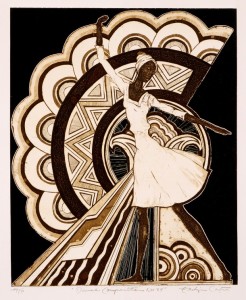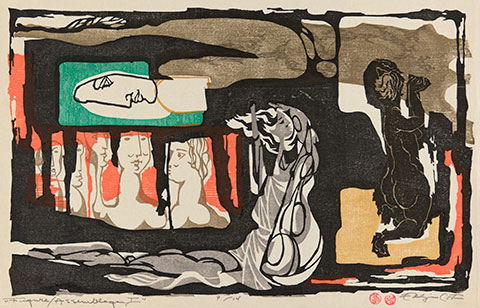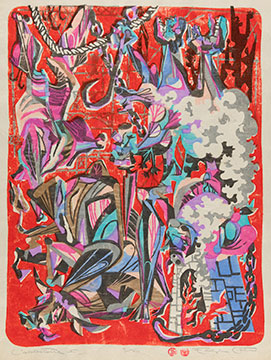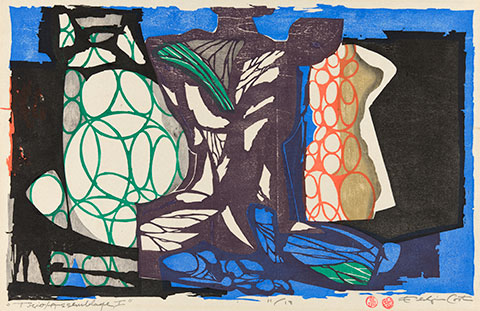
Eldzier Cortor, Chicago 1916.
Dance Composition 34, 1971-1972.
About:
A Chicago native, Eldzier Cortor (1916) entered the School of the Art Institute of Chicago in 1936 and came under the influence of instructor Kathleen Blackshear, who led students to explore the regional arts of Africa and other non-Western cultures at the Field Museum and Oriental Institute in Chicago. At the same time, Cortor, like his peers in the Harlem Renaissance, was inspired by philosopher Alain Locke’s call for African American artists to reclaim their ancestral heritage as a means of strengthening and enriching their expression.
Environment Nr. V, 1969.
Figure Assemblage 1, 1959
These two influences can be seen at play throughout his career, even from its earliest moments. Working with the Federal Arts Program from 1938 to 1943, Cortor focused on African American social life on Chicago’s South Side. Later, living and painting among the Gullah people (formerly enslaved Africans) on the Sea Islands off South Carolina, he became fascinated by their deep cultural connection to their African roots. His experiences with the Gullah fostered his decision to depict Woman as the archetypal image of all people. Eventually, this focus evolved to combine Woman and Dance, as shown in so many of the prints in this exhibition.
Although Cortor primarily worked with intaglio printmaking processes, he produced several woodblock prints in the mid-1950s with Japanese printmaker Jun’ichiro Sekino, a leading member of the Sosaku Hanga, or Creative Prints, movement. Five works from this period are on display, demonstrating the highly original hybrid of Western and Japanese techniques that resulted from Cortor and Sekino’s close collaboration.
L’Abbatoire 1, 1950s.
Also on view are some of Cortor’s experimental prints made in Manhattan at Robert Blackburn’s Printmaking Workshop, where he worked between 1955 and 1998. Some of these bear the title Abattoir, literally “slaughterhouse.” Although the artist was familiar with Chicago’s notorious meatpacking industry, his works allude to the harsh environment he found in Haiti after several friends were killed by François “Papa Doc” Duvalier’s dictatorial regime.
Trio Assemblage 1, 1950s.
Bringing together examples of Cortor’s work throughout his remarkable career, this focused exhibition celebrates not only the artist’s tireless innovation but also his tremendous generosity in sharing his work with the museum and our visitors. Thus the Art Institute is pleased to announce that Cortor, who turns 99 this January, will be this year’s recipient of the Leadership Advisory Committee’s Legends and Legacy Award, an honor recognizing African American artists who have achieved national acclaim with careers spanning over 50 years.(text website Art Institute of Chicago)




